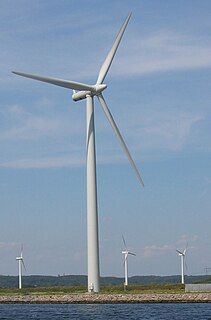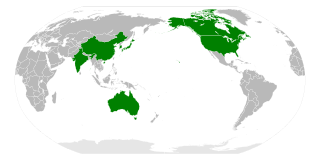
The Kyoto Protocol is an international treaty which extends the 1992 United Nations Framework Convention on Climate Change (UNFCCC) that commits state parties to reduce greenhouse gas emissions, based on the scientific consensus that (part one) global warming is occurring and (part two) that human-made CO2 emissions are driving it. The Kyoto Protocol was adopted in Kyoto, Japan, on 11 December 1997 and entered into force on 16 February 2005. There are currently 192 parties (Canada withdrew from the protocol, effective December 2012) to the Protocol.
Emissions trading is a market-based approach to controlling pollution by providing economic incentives for reducing the emissions of pollutants.
Environmental finance is a field within finance that employs market-based environmental policy instruments to improve the ecological impact of investment strategies. The primary objective of environmental finance is to regress the negative impacts of climate change through pricing and trading schemes. The field of environmental finance was established in response to the poor management of economic crises by government bodies globally. Environmental finance aims to reallocate a businesses resources to improve the sustainability of investments whilst also retaining profit margins.
A carbon credit is a generic term for any tradable certificate or permit representing the right to emit one tonne of carbon dioxide or the equivalent amount of a different greenhouse gas (tCO2e).

A carbon offset is a reduction in emissions of carbon dioxide or other greenhouse gases made in order to compensate for emissions made elsewhere. Offsets are measured in tonnes of carbon dioxide-equivalent (CO2e). One tonne of carbon offset represents the reduction of one tonne of carbon dioxide or its equivalent in other greenhouse gases.

The Asia-Pacific Partnership on Clean Development and Climate, also known as APP, was an international, voluntary, public-private partnership among Australia, Canada, India, Japan, the People's Republic of China, South Korea, and the United States announced July 28, 2005 at an Association of South East Asian Nations (ASEAN) Regional Forum meeting and launched on January 12, 2006 at the Partnership's inaugural Ministerial meeting in Sydney. As of 5 April 2011, the Partnership formally concluded although a number of individual projects continue. The conclusion of the APP and cancellation of many of its projects attracted almost no media comment.

Individual and political action on climate change can take many forms. Many actions aim to build social and political support to limit and reduce the concentration of greenhouse gases (GHGs) in the atmosphere, with the goal of mitigating climate change. Other actions seek to address the ethical and moral aspects of climate justice, especially with regard to the anticipated unequal impacts of climate change adaptation.
Flexible mechanisms, also sometimes known as Flexibility Mechanisms or Kyoto Mechanisms, refers to Emissions Trading, the Clean Development Mechanism and Joint Implementation. These are mechanisms defined under the Kyoto Protocol intended to lower the overall costs of achieving its emissions targets. These mechanisms enable Parties to achieve emission reductions or to remove carbon from the atmosphere cost-effectively in other countries. While the cost of limiting emissions varies considerably from region to region, the benefit for the atmosphere is in principle the same, wherever the action is taken.
Greenhouse gas inventories are a type of emission inventory that are developed for a variety of reasons. Scientists use inventories of natural and anthropogenic (human-caused) emissions as tools when developing atmospheric models. Policy makers use inventories to develop strategies and policies for emissions reductions and to track the progress of those policies. Regulatory agencies and corporations also rely on inventories to establish compliance records with allowable emission rates. Businesses, the public, and other interest groups use inventories to better understand the sources and trends in emissions.

The Carbon Pollution Reduction Scheme was a cap-and-trade emissions trading scheme for anthropogenic greenhouse gases proposed by the Rudd government, as part of its climate change policy, which had been due to commence in Australia in 2010. It marked a major change in the energy policy of Australia. The policy began to be formulated in April 2007, when the federal Labor Party was in Opposition and the six Labor-controlled states commissioned an independent review on energy policy, the Garnaut Climate Change Review, which published a number of reports. After Labor won the 2007 federal election and formed government, it published a Green Paper on climate change for discussion and comment. The Federal Treasury then modelled some of the financial and economic impacts of the proposed CPRS scheme.
Carbon emissions trading is a form of emissions trading that specifically targets carbon dioxide (calculated in tonnes of carbon dioxide equivalent or tCO2) and it currently constitutes the bulk of emissions trading.

Canada was active in the negotiations that led to the Kyoto Protocol in 1997. The Liberal government that signed the accord in 1997 ratified it in parliament in 2002. Canada's Kyoto target was a 6% total reduction in greenhouse gas (GHG) emissions by 2012, compared to 1990 levels of 461 megatonnes (Mt). Despite signing the accord, greenhouse gas emissions increased approximately 24.1% between 1990 and 2008. In 2011, Conservative Prime Minister Stephen Harper withdrew Canada from the Kyoto Protocol.

Greenhouse gas emissions by Australia per capita are still well above the OECD, and developed world average, with most sources pointing to 22-25 tons. Australia has one of the highest per capita emissions of greenhouse gas in the world, with its 0.33% of the world's population releasing 1.07% of the world's greenhouse gases, contributing to global climate change. Australia uses principally coal power (70%) for electricity but this is decreasing with a growing share of renewables making up the energy supply mix. Emissions by the country have started to fall and are expected to continue to fall in coming years as more projects come online.

The New Zealand Emissions Trading Scheme is a partial-coverage all-free allocation uncapped highly internationally linked emissions trading scheme. The NZ ETS was first legislated in the Climate Change Response Amendment Act 2008 in September 2008 under the Fifth Labour Government of New Zealand and then amended in November 2009 and in November 2012 by the Fifth National Government of New Zealand.
Although it is a worldwide treaty, the Kyoto Protocol has received criticism.
This article is about the Kyoto Protocol and government action in relation to that treaty.
The Climate Change Response Amendment Act 2008 was a statute enacted in September 2008 by the Fifth Labour Government of New Zealand that established the first version of the New Zealand Emissions Trading Scheme, a national all-sectors all-greenhouse gases uncapped and highly internationally linked emissions trading scheme.
A carbon pricing scheme in Australia was introduced by the Gillard Labor minority government in 2011 as the Clean Energy Act 2011 which came into effect on 1 July 2012. Emissions from companies subject to the scheme dropped 7% upon its introduction. As a result of being in place for such a short time, and because the then Opposition leader Tony Abbott indicated he intended to repeal "the carbon tax", regulated organisations responded rather weakly, with very few investments in emissions reductions being made. The scheme was repealed on 17 July 2014, backdated to 1 July 2014. In its place the Abbott Government set up the Emission Reduction Fund in December 2014. Emissions thereafter resumed their growth evident before the tax.

Green economy policies in Canada are policies that contribute to transitioning the Canadian economy to a more environmentally sustainable one. The green economy can be defined as an economy, "that results in improved human well-being and social equity, while significantly reducing environmental risks and ecological scarcities." Aspects of a green economy would include stable growth in income and employment that is driven by private and public investment into policies and actions that reduce carbon emissions, pollution and prevent the loss of biodiversity.
The history of climate change policy and politics refers to the continuing history of political actions, policies, trends, controversies and activist efforts as they pertain to the issue of global warming and other environmental anomalies. Dryzek, Norgaard, and Schlosberg suggest that critical reflection on the history of climate policy is necessary because it provides 'ways to think about one of the most difficult issues we human beings have brought upon ourselves in our short life on the planet’.








